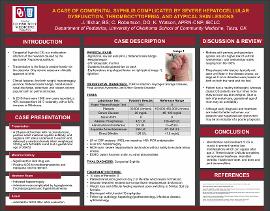| dc.description.abstract | INTRODUCTION: Congenital Syphilis (CS) is an infection caused by the spirochete Treponema Pallidum. It’s transmitted predominantly via the placenta, and only severe cases are clinically apparent at birth. Its incidence has risen sharply, with the CDC reporting 1306 cases in 2018, a 40% increase from 2017 nationally with a 92% increase in Oklahoma alone.
CASE DESCRIPTION: A 28-year-old mom with no prenatal care and a positive admit maternal syphilis antibody underwent C-section and delivered a newborn female infant weighing at 3020 g with APGARS 6 and 9 at a gestational age of 38w5d. Maternal history was significant for illicit drug use and positive UDS for methamphetamine and marijuana prior to delivery. NB exam showed hypotonia, low-set ears, flattened nasal bridge, 2/6 holosystolic murmur, hepatomegaly, scattered petechiae on the back, an erythematous ring-shaped lesion on right palm, and another similar lesion on right foot. NB admission was complicated by hypoglycemia, thrombocytopenia and hyperbilirubinemia. Patient was admitted to NICU soon after delivery. Lumbar puncture with CSF analysis yielded RPR 1:64 and non-reactive VDRL. ECHO showed a small PFO. A diagnosis of CS was made anda 10-day course of IV Penicillin G was initiated. LFT showed transaminitis and TPN/SMOF was begun. Abdominal ultrasound confirmed hepatomegaly and HIDA scan results were consistent with severe hepatocellular dysfunction without exclusion of biliary atresia. The lowest direct bilirubin was 1.96 and lowest platelet level was 30. One platelet transfusion was administered and Ursodiol 10 mg/kgs was initiated. She was discharged with Ursodiol 15 mg/kgs and will be following up with the Audiology, Hepatology, Gastroenterology, Infectious Disease, and Opthalmology pending referral from PCP.
DISCUSSION: This case illustrates the various clinical findings seen in classic CS as well as those unique to our patient. Interestingly, our patient had a healthy birthweight, whereas classic CS patients are four times more likely to have low birth weights. Distinctive features of this case include the ring-shaped skin lesions as large as 2 cm in diameter which were present at birth. The rash of CS usually appears later on in the disease course and consists of small brown/copper colored spots on the palm or soles. Another noteworthy finding in this case was the severe involvement of the liver requiring treatment with Ursodiol. Although early diagnosis and treatment is linked to better outcomes, our patient’s vast hepatocellular dysfunction may be an indicator of a poorer prognosis. The rising prevalence of CS may make these exam findings more common. | en_US |

